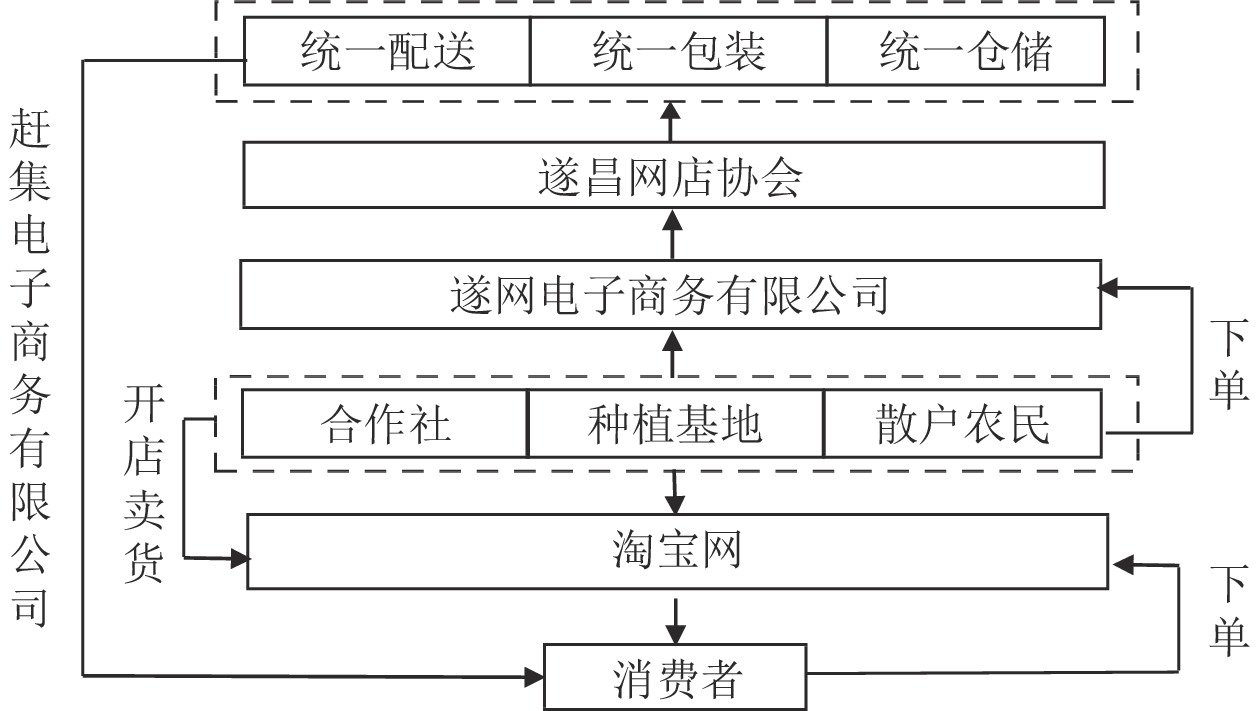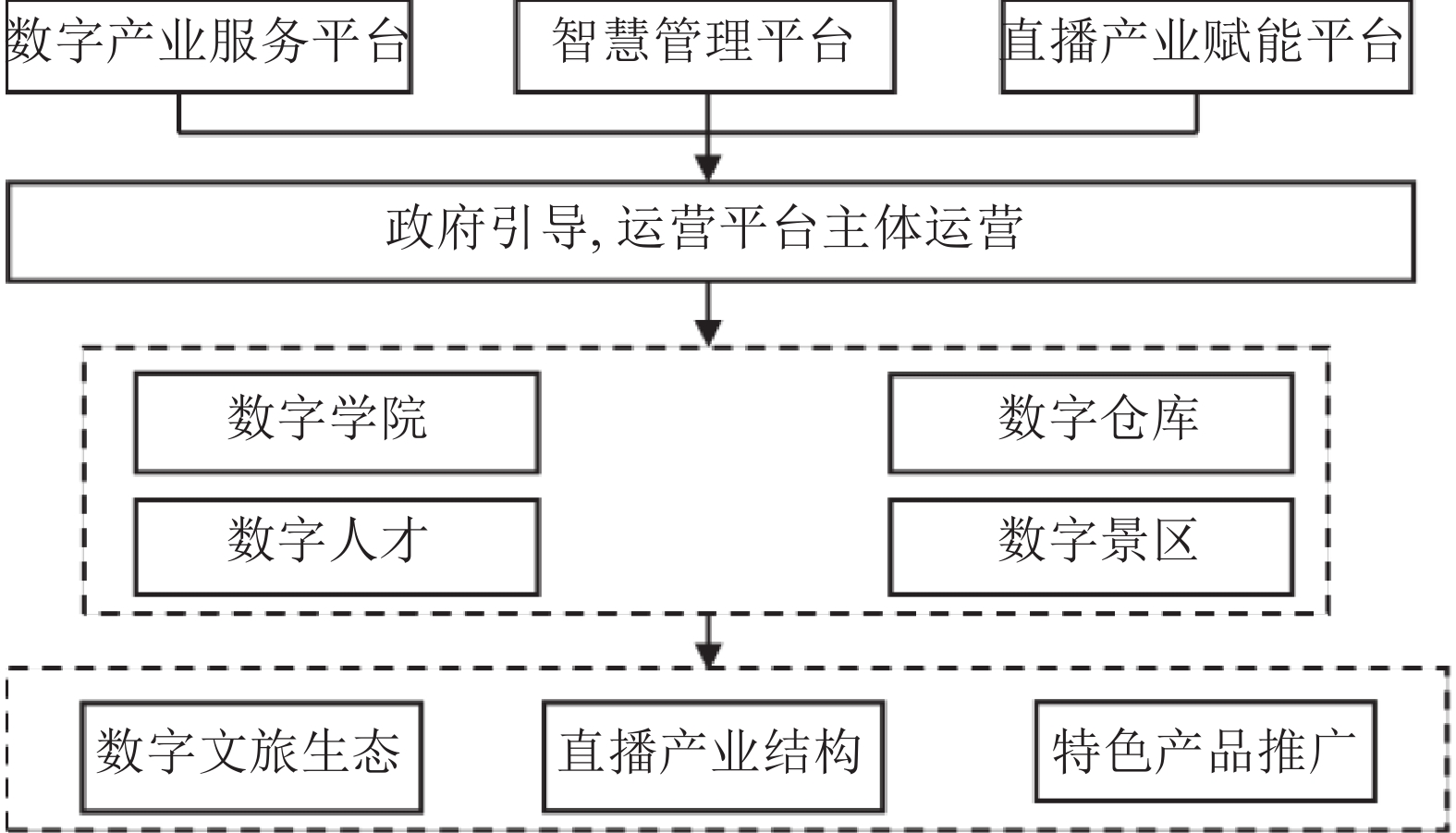-
浙江省作为全国经济发展水平较高地区,在探索解决发展不平衡不充分问题方面成效显著,尤其在推动26个山区县高质量发展方面,其经验与启示值得推广。26个山区县面积占全省面积的44.5%,但2020年国内生产总值总量不到全省的10%[1]。不同区域之间收入分配差距过大,会使得社会各类资源要素错配,长此以往将导致资本要素固化,经济增长乏力,不利于实现共同富裕。因此,推进26个山区县跨越式高质量发展,将是浙江建设共同富裕示范区、协调地区发展的重点和难点。
围绕区域协调发展问题,学者们展开了一系列分析和探讨。有学者指出:公共基础设施的缺失[2]、科技和资金等现代化生产要素的不发达[3]限制了欠发达地区的发展。因此,要通过城乡统筹发展的方式带动要素配置[4],促进结构变迁效应,进而促进欠发达地区经济发展。也有学者指出山区县大多是一些自然资源富集但经济欠发达的地区,要实现共同富裕应当实现“转劣为优,变废为宝”的生态产品价值实现机制[5],同时需要推动民营资本来壮大生态经济,也需要新时代民营企业家精神规范引导资本下乡[6]。
尽管学者们已经展开了深入探讨,但如何提升欠发达地区发展水平,仍是当前乃至今后研究的趋势。目前,数字经济已成为中国经济社会发展的重要推动力,也为缓解相对贫困和实现农户共同富裕提供动力支持。数字化能弥补发展不足的原因在于:第一,数字化能够创造新的业态,带动就业[7],有助于家庭收入增加;第二,数字化有效降低了农业生产经营过程中的交易成本[8],获利空间增加,促进产业链延伸,带动经济发展。第三,数字化有利于提升人力资本[9],吸引返乡创业,收入提升的可能性增加。
本研究从山区县乡村产业入手,阐释数字化促进乡村产业发展的作用机制,并通过“常山县物联网模式”“遂昌县农村电商模式”和“淳安县互联网+特色农业模式”3个山区县的个案实践进行现实检验,弥补当前山区县乡村产业发展的弱势,推动山区县跨越式、高质量发展,助力农民农村共同富裕,为山区县发展乡村数字产业提供参考。
-
信息效应理论常被用于研究信息获取对决策者行为的影响[10]。在市场交易过程中,信息掌握不充分的一方会因获取不完整信息而承担更高昂的交易成本,获得信息的效用大大降低[11],影响创新发展能力的提升。数字信息化能够提升信息传播能力、降低交易成本、提高人力资本等,进而赋能乡村产业,为农村产业发展模式和组织形态提供新的机会,促使农村农业资源整合、信息共享和要素互联,促进第一、二、三产业融合,推动农业产业全面升级[12]。
首先,数字化通过创造新业态、带动就业促进乡村产业发展。数字信息化是以数字信息和数字技术为软硬件,嵌入到农业生产、流通、服务、管理等环节,形成新产业、新业态、新模式。第一,以互联网为载体的新业态,催生了网络直播等新兴产业,创造了大量的就业机会,使得劳动者选择工作的方式更加灵活[13],就有可能产生职业化农民和兼业化农民[14],进而促进乡村产业发展。第二,以电商为载体的新业态,极大地带动了快递、仓储和包装等细分领域,不仅可以直接提供新的就业机会,还有可能提供间接就业岗位[15],促进农村非农就业的转移[16],且该效应在偏远地区的作用更为明显[17]。第三,以物联网为载体的新业态,通过传感器感知等物联网技术显著提升劳动生产效率,节约劳动力雇佣成本,有助于推动企业扩大生产规模,为农民非农就业提供了更多的就业岗位,进而促进乡村产业发展。
其次,数字化通过降低交易成本,提高获利空间进而促进乡村产业发展。传统的农业产业模式由于地域限制,参与主体众多,往往存在收购价格和销售价格差距大,极大损害了农户和消费者的利益[18]。数字信息化下,新一代信息技术逐渐被应用到农业领域。第一,去除了冗长的中间商。数字信息化下,买卖双方可以突破时空限制,产品供求信息的实时流动有助于提高农产品流通效率[19],大幅度降低交易成本[20]。第二,引导生产,以销定产。通过互联网平台提高了网商整合和利用信息的能力,有益于农户密切关注市场需求和产品动态,提升生产策略调整的灵活性,提高生产效益[21]。第三,扩大消费者群体,增加销售量。数字信息化下,信息的搜寻成本降低,消费者可以更好地了解产品信息及更方便购买商品,有助于扩大农产品的交易范围[22]。同时,还可有助于打造品牌效应,提高消费者对产品的信任度,进而提高获利空间,在潜移默化中有效驱动乡村产业深度转型,实现“造血式”致富[23]。
最后,数字化通过提升人力资本,吸引返乡创业进而促进乡村产业发展。数字信息化时代是以数据为主要生产要素,这就对劳动者素质提出了一定的要求。第一,劳动者为适应数字经济就业的需要,会通过网上的学习和系统的培训[24],不断提高自身劳动技能[25],使得高技能劳动力占比快速上升,低技能劳动力稳中有升[26],有助于吸引年轻人返乡创业,赋能乡村产业发展。第二,数字化带来了创业机遇,有助于促进信息传播与扩散,减少投资者和创业者之间的信息不对称[27],增强风险控制能力[28];也有助于降低融资门槛,提高共享金融的包容性[29];更有助于促进劳动者社交网络的积累,提高社会资本[30]。
-
本研究选取了浙江省3个典型的山区县(常山县、遂昌县和淳安县)进行实地走访。3个县中,淳安县处于经济发展水平和信息化发展程度较高地区的杭州市,常山县处于经济发展水平和信息化发展程度较一般的衢州市,而遂昌县处于经济发展水平相对欠发达且信息化发展程度相对弱势的丽水市。通过座谈会和一些关键信息人访谈,了解该县自然经济特征、数字基础设施情况、数字产业发展情况等。访谈内容包括:①县经济发展状况;②县数字化基础设施情况;③县数字乡村产业发展情况;④县数字乡村产业特色模式。
-
浙江省总体经济发展较好,而3个案例县相较于省经济发展平均水平有一定的差距。在人均生产总值方面,2020年浙江省为10 0620元,其中,常山县、遂昌县和淳安县分别为61 786、67 582和73 026元;在第一、二、三产业人均产值方面,浙江省分别为3 354、40 836和55 707元,其中,常山县、遂昌县和淳安县第一产业人均产值相较于省平均水平较高,分别为3 203、6 265和11 672元,而第二、三产业人均产值县相较于省平均水平较低,第二产业分别为26 025、24 095和18 967元,第三产业分别为38 938、35 088和42 492元。在农村居民人均可支配收入方面,浙江省为31 930元,其中,常山县、遂昌县和淳安县分别为24 033、22 264和22 465元(表1)。
地区 人均生产
总值/元第一产业人均
产值/元第二产业人均
产值/元第三产业人均
产值/元城镇居民人均
可支配收入/元农村居民人均
可支配收入/元浙江省 100 620 3 354 40 836 55 707 62 699 31 930 衢州市 72 192 4 039 28 973 38 938 49 300 26 290 常山县 61 786 3 203 26 025 32 345 41 890 24 033 丽水市 61 811 4 187 22 129 35 088 48 532 23 637 遂昌县 67 582 6 265 24 095 36 924 50 425 22 264 杭州市 136 617 2 725 40 293 91 592 68 666 38 700 淳安县 73 026 11 672 18 967 42 492 48 985 22 465 说明:数据来源于《2021年浙江统计年鉴》。 Table 1. Basic economic situation of the county and city in the case in 2020
-
浙江拥有良好的互联网发展环境,这为山区县发展数字乡村产业构建了良好的互联网发展环境。根据《浙江省互联网发展报告》,浙江宽带网络基础设施建设全国领先,网民规模和互联网普及率都高于全国平均水平。“十三五”期间,浙江省网民规模增长了49.11%,增幅高于全国平均水平5.41%;截至2020年12月,浙江省互联网普及率达82.40%,高于全国平均水平12.00%。浙江省互联网宽带接入端口从2016年的4 695万个至2020年的6 032万个,移动互联网用户从2016年的6 366万个至2020年的7 041万户,互联网宽带接入用户从2016年的2 160万户至2020年的2 939万户,其中农村互联网宽带接入用户从2016年的495万户至2020年的893万户(表2)。
年份 网民规模/
万人互联网普
及率/%互联网宽带接入
端口/万个移动互联网
用户/万户互联网宽带接入
用户/万户城市宽带接入
用户/万户农村宽带接入
用户/万户2016 3 632.0 65.60 4 695 6 366 2 160 1 664 495 2017 3 956.0 70.80 5 455 7 456 2 465 1 860 604 2018 4 543.7 79.20 6 115 8 136 2 648 1 746 902 2019 4 729.8 80.90 6 284 7 047 2 782 1 860 922 2020 5 321.8 82.40 6 032 7 041 2 939 2 046 893 说明:数据来源于《2017—2021年浙江统计年鉴》和《浙江省互联网发展报告》。 Table 2. Basic situation of digital infrastructure in Zhejiang Province from 2016 to 2020
然而,不同案例县所在市的数字基础设施存在较大差距。至2020年,常山县所在的衢州市固定互联网宽带接入用户有98万户,移动互联网用户198万户;遂昌县所在的丽水市,固定互联网宽带接入用户有100万户,移动互联网用户215万户;淳安县市所在的杭州市固定互联网宽带接入用户有634万户,移动互联网用户1 464万户(表3)。
地区 固定互联网宽带
接入端口/万个移动互联
网用户/万户固定互联网宽带
接入用户/万户衢州市 206 198 98 丽水市 203 215 100 杭州市 1 189 1 464 634 说明:数据来源于《2021年浙江统计年鉴》。 Table 3. Basic information of digital infrastructure of the city where the case county is located in 2020
根据《2021浙江省数字经济发展综合评价报告》,3个案例县在全省各县的数字经济发展综合评价中均在第5层次,得分为70~80分,排名落后。但在26个县的数字经济发展综合排名靠前,并且3个案例县所在市在产业数字化、数字产业化和新业态新模式还是存在不同的亮点。常山县所在的衢州市总指数为74.3分,在全省11个市中排名第8位,但其产业数字化指数得分为102.1,全省排名第2位;淳安县所在的杭州市总指数为137.2分,全省排名第1位,其基础设施、产业数字化、数字产业化等得分都相对较高,全省排名均为1;遂昌县所在的丽水市总指数为67.3分,在全省排名第11位,但其新业态新模式指数得分为95.8分,全省排名第2位(表4)。可见,尽管所选案例县与其他发达地区的数字经济发展总指数存在差异,但就从其所处市的某个数字产业指标指数看,其排名较为靠前,表明所选案例县在某些数字产业方面具有一定的特色性和典型性。
地区 基础设施 数字产业化 产业数字化 新业态新模式 政府和社会数字化 总指数 得分 排名 得分 排名 得分 排名 得分 排名 得分 排名 得分 排名 衢州市 69.9 10 57.3 10 102.1 2 58.8 8 90.8 9 74.3 8 丽水市 59.0 11 52.2 11 65.6 11 95.8 2 84.7 11 67.3 11 杭州市 102.6 1 164.5 1 132.0 1 159.6 1 110.6 1 137.2 1 说明:数据来源于《2021浙江省数字经济发展综合评价报告》。 Table 4. Comprehensive evaluation results of digital economy development in the city where the case county is located in 2020
综上,山区县虽然地处偏远,交通不便,与全省经济发展水平以及各类基础设施包括数字基础存在一定的落差,但浙江省作为数字经济大省,数字经济又具有高渗透性、外部经济性和边际效益递增性等特点,山区县依然可以依靠数字化因地制宜地发展特色产业。常山县独特的生态环境孕育了胡柚Citrus paradisi、油茶Camellia oleifera、猴头菇Hericium erinaceus三大产业。据统计,油茶种植面积为1.87万hm2,其中油茶产业总值达12亿元。通过发展产业数字化,引入物联网基础设施,可以极大提高产业的科学化、规模化和标准化,提高土地生产率和劳动生产率,促进农民致富。遂昌县历属传统农业地区,长期以种植粮食作物为主,拥有茶叶、竹业、生态蔬菜、生态畜牧业和水果干果五大主导产业。过去农产品销售渠道受限,造成当地经济发展缓慢。遂昌县通过新业态新模式的发展,构建了优良的电子商务环境,有助于扩大农产品的销售渠道,提高农民的收入。优质的生态环境是淳安旅游业的生命线,但是由于区位劣势加上受到疫情的影响,使得各大景区和民宿的游客接待人次和收入均下降。通过发展数字化产业,构建“消薄网红楼”,打造直播小镇,培养农民主播,可以让乡村旅游业实现成功转型升级,让农民增收致富。
-
以“乡村大脑”的常山农业物联网模式主要打造数字乡村产业园,借助物联网等技术实现县域内农产品及其深加工产品从种养、加工、物流到营销的全过程质量安全溯源,打造智慧农业,保证农产品安全信誉的发展模式,促进产业的专业化与规模化。
常山农业物联网模式以柚香谷等农业数字工厂为引领,搭建起了数字乡村产业的队伍(图1)。数字农业工厂在产前打造数字基础设施,引入智能化种养设备、机械化生产车间等新型基础设施,实现“机器换人”,提高农业生产效率。在产中实现科学产销,生产方面对胡柚生产加大水肥一体、智能温控等控制农产品质量追溯,并通过“乡村大脑”采集分析生产数据信息,实现对胡柚产业的精准指导;销售方面引用物流端数据采集与个性化推送技术,拓展农产品销售客户群。在产后实现安全溯源。推出上市农产品“一证两码”,打通农资购销和农产品质量追溯两大系统。截止2021年,全县建成数字化种养基地23家,胡柚从业人员达10万余人,总产值突破35亿元。2020年该县全体居民人均可支配收入增速,位居26个县首位,农民收入和低收入农户收入分别增长8.5%、14.9%,增幅均居全市第3位。
借鉴常山数字农业工厂物联网模式,一方面可以实现从种养、加工、物流到营销等细分领域的科学化和专业化,直接带来就业机会;另一方面,通过对大数据分析处理,可以提升土地资源利用率和劳动生产率,进而可以扩大生产规模,提供了更多的就业岗位。农业生产具有自然和经济双重属性,传统的农业种植流程中完全依靠个人经验来进行,对气候、光照等条件不确定性大,往往会导致投入与产出不成正比。而农业物联网模式通过物联网技术远程监控当前农作物的基本状态,并且通过监测设备感知当前气象、光照等条件,充分发挥其在节约农用物资和节约农村劳动力等方面的作用,促进农业产销向智能化、精准化方向、规模化转变。
-
以“综合服务驱动示范”的遂昌电商模式通过“综合服务商”为千余小卖家提供专业的培训服务,制定产销标准,统一包装,统一仓储和售后服务等,不断为网商提供解决方案,实现了产业的标准化与品牌化,促进产业升级。
遂昌电商模式始于2010年,其核心是农村电商综合服务商麦特龙分销平台,它由遂昌网店协会、浙江遂网电子商务有限公司和浙江赶集电子商务有限公司组成。遂昌网店协会通过联合政府负责对网店创业者进行培训,提高网商能力,增加网店的规模和数量,增加就业岗位;浙江遂网电子商务有限公司整合农业资源和互联网生态,负责收购农户或企业竹炭、竹笋等特色农产品,加工、包装后发往网商平台,形成统一的产销标准;浙江赶集电子商务有限公司在遂昌县每个村建立村级服务站,通过赶集物流形成农村消费下行体系和农产品上行体系并存的特色模式(图2)。据统计,目前全县直接从事农村电商者超过1.1万人,在电商主流网络平台上注册登记网店4 561家,通过网络直销模式,本地竹炭、烤薯等农产品普遍溢价20%~30%;与此同时,遂昌县农村居民收入增幅持续提高。2020年,遂昌县农村居民人均可支配收入增幅18.4%,达22 264元。
遂昌县农村电商模式,一方面大量的数据信息可以实现产品供求信息的市场流动,综合协会可以积极布局本地市场,进行统一产销,有助于降低交易成本,提高产品的流通范围与流通效率;另一方面,实施标准化“七统一”模式,把控产品源头的质量,有助于本地区农产品品牌的建设,提升网商市场竞争力,提高产品的溢价能力,增加获利空间。山区县的数字产业化发展还处于初级阶段,一些山区县没有结合本地区实际发展产业,导致同质化现象严重[31],可能会带来一时的经济利益,但是没有形成本地特色优势和特色品牌,长此以往容易被市场淘汰。
-
以“互联网+特色小镇”的淳安互联网特色农业模式通过“直播小镇”这个点为中心,以点带面,实现乡村旅游和农产品销售的二次转型,实现了“乡村旅游+民宿+农趣+农产品销售”四合一,促进产业的特色化和品牌化。
淳安直播小镇的本体是淳安县左口乡自然村,在网红经济兴起后,直播小镇应运而生,其运作方式主要包含4个部分:一是成立数字学院。通过蓝马商学院开展各类线上线下直播培训,专门培训本土农民主播。二是招揽数字人才。在政府的支持下打造研学和场景式的直播教学基地,配备培训室和直播间等硬件场所,吸引带货主播和娱乐主播进驻。三是打造数字仓库。积极为本土农产品开拓市场,强化与县农产品品牌企业合作,不断丰富供应仓种类。四是推动数字景区。以民宿特色村为背景,加快传统民宿转型,“直播+民宿”助推乡村产业发展(图3)。截至目前,已培训直播学员2 000余人,通过直播推介水蜜桃Prunus persica等20余种农产品,线上销售产值560余万元,每年可为村集体增加15万元经营性收入;同时,2020年全乡实现旅游总收入5 072万元,其中通过民宿“云推介”线上销售客房订单达90万元。
淳安特色直播小镇模式,一方面通过线上线下的直播培训,打造了一大批本土农民人才,提高了农民的素质和能力,有效整合农村资源和要素,促进产业链条的纵横延伸;另一方面,通过“直播小镇”这种新兴互联网形式,有助于提升特色农业的知名度,带动农业及相关服务业的发展,吸引年轻人返乡创业。大部分山区县地处偏远,经济发展相对落后,即使拥有一些比较好的文旅产业,也难以被消费者发现。而数字信息化下的直播经济可以充分利用网络直播的宣传力和影响力,对当地的特色旅游景点及特色农产品等起到非常好的宣传和推广作用。
-
新一代数字信息技术的发展将深刻影响和改变乡村产业的生产力和生产关系,进而驱动乡村产业深度转型。但考虑到山区县发展要素稀缺,产业发展薄弱等现实问题,因此适当借鉴和推广这3个山区县通过数字信息化赋能乡村产业的模式,有助于产业兴旺和乡村振兴。但与此同时,在借鉴案例经验时,存在一定的约束条件。
常山农业物联网模式适用于一些农业发展基础比较好的地区以及具有高价值的农产品方面,原因在于搭建农业物联网基础设施需要很高的成本,目前使用物联网基础所增加的成本与农产品的经济效益相比还显得过高,因此需要有一定规模的生产基地、农场或农业园区等。另外,由于农业物联网模式依靠智能软件对大量数据的收集、处理和智能控制,对相关农业科技人才和农业工作者要求稍高,需要彼此之前相互协作。
遂昌电商模式适用于电商根底弱、小品牌小网商多的区域,通过核心“综合服务商”,搭建全产业链,让上游生产端和下游销售端专注于自己擅长的工作,提高运行效率和竞争力,但服务商属于半公益性质,需要政府鼎力支持;该模式比较适用于县域开展电商的初期,由于综合服务商的重要作用,一方面对综合协会的负责人要求会比较高,另一方面一旦该环节出了问题很容易导致全产业链的停顿运行。
淳安特色直播小镇模式主要适用于有一定的特色产业基础或者拥有特色自然景观等优势,其模式要结合本地区的自然环境和经济等因素,积极培养本土人才,在政府+企业+村集体+农户的齐心协力下打造本地区的特色产业,实现一县一品;该模式比较适用于有一定网络等信息媒介基础的地区,其原因在于当前直播这种相对新颖的媒介并没有在农村发挥较大的传播作用,同时能够熟练运用新媒体进行网络直播的人集中在青年群体。
-
山区县应积极调动现有资源,探索推进以物联网、人工智能等为代表的基建建设和应用。①打造数字化新型基础设施。生产方面深化物联网在农业装备方面的应用,引入智能化、自动化新型基础设施,销售方面推进农村电商公共服务体系;②加大科技研发支持力度。加速推进相关农业企业的集聚,增进产学研深度融合,加快推动物联网科技成果转化应用;③建设农业农村大数据中心,大力推动农产品全产业链大数据的跟踪与利用。
-
培养高素质的数字专业人才是数字乡村产业高质量发展的先决条件。①提高农民的数字化素养。加大现代信息技术知识的宣传和教育,组织新媒体培训,引用短视频等新型媒介,培养农民新媒体技能;②加强地方特色主导产业的人才培养。开展智慧农业和农村电商等专题培训活动,以专业大户、家庭农场等新型农业经营主体为重点对象,精准培训一批掌握数字化农业技术的高素质农民,提高创业和就业机会;③注重从外部吸纳数字化专业人才。加强与农业类院校的合作,制定符合当地实际发展需求的数字化人才引进方案。
-
山区之间资源禀赋各有差异,要深度结合山区自身特色,才能有效带动特色资源的互联网产业化。既可以从自然景观等旅游资源入手,也可以从特色农产品或者是特色人文资源入手,利用数字化技术,进行全方位开放和传播,吸引更多受众对象。充分利用新媒体对品牌的推动作用,打造特色品牌,强化农产品网上销售质量监管制度,切实保障农产品及网上销售的质量安全,提升网销竞争力。
Zhejiang experience and enlightenment of digital rural industry development in mountainous counties
doi: 10.11833/j.issn.2095-0756.20220592
- Received Date: 2022-09-16
- Accepted Date: 2023-04-20
- Rev Recd Date: 2023-04-15
- Available Online: 2023-07-13
- Publish Date: 2023-08-20
-
Key words:
- digital countryside /
- industry development /
- mountainous counties /
- Zhejiang experience
Abstract:
| Citation: | REN Qin, SHEN Yueqin, ZHU Zheyi. Zhejiang experience and enlightenment of digital rural industry development in mountainous counties[J]. Journal of Zhejiang A&F University, 2023, 40(4): 901-909. DOI: 10.11833/j.issn.2095-0756.20220592 |




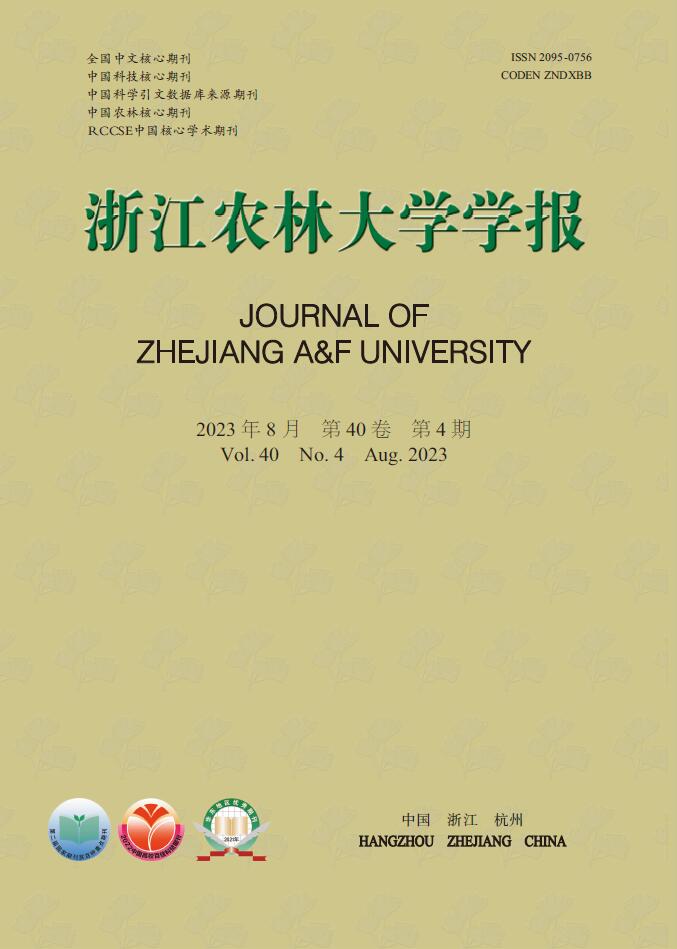


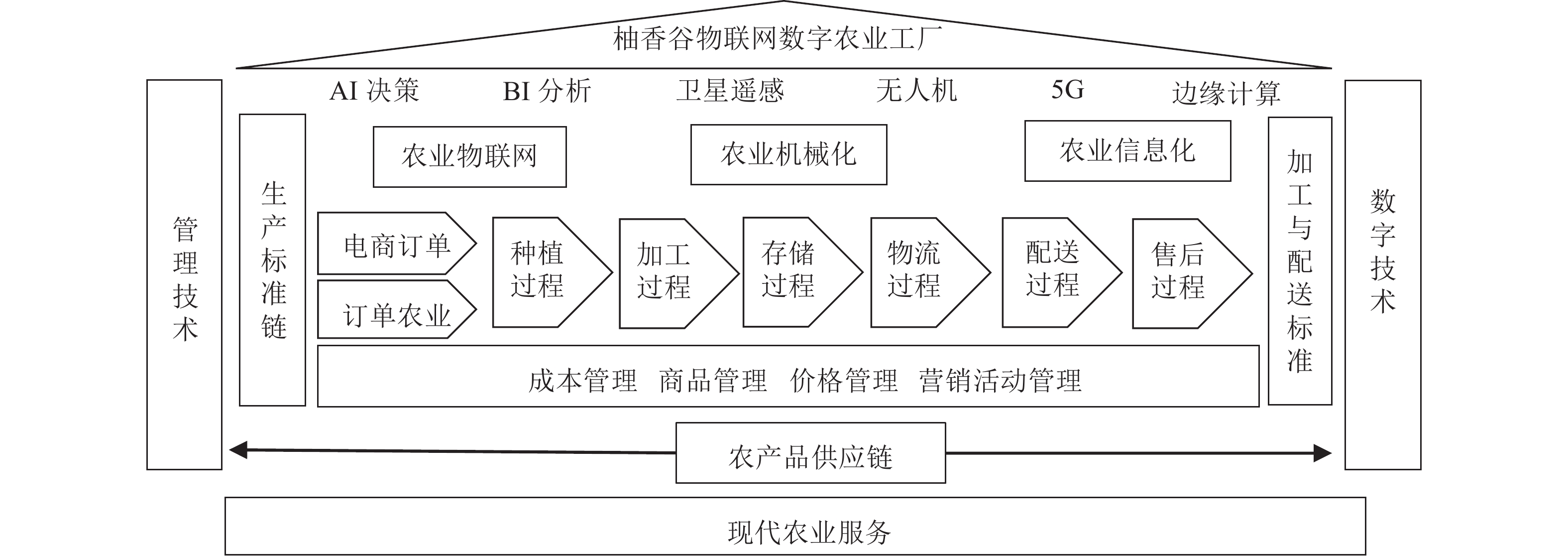


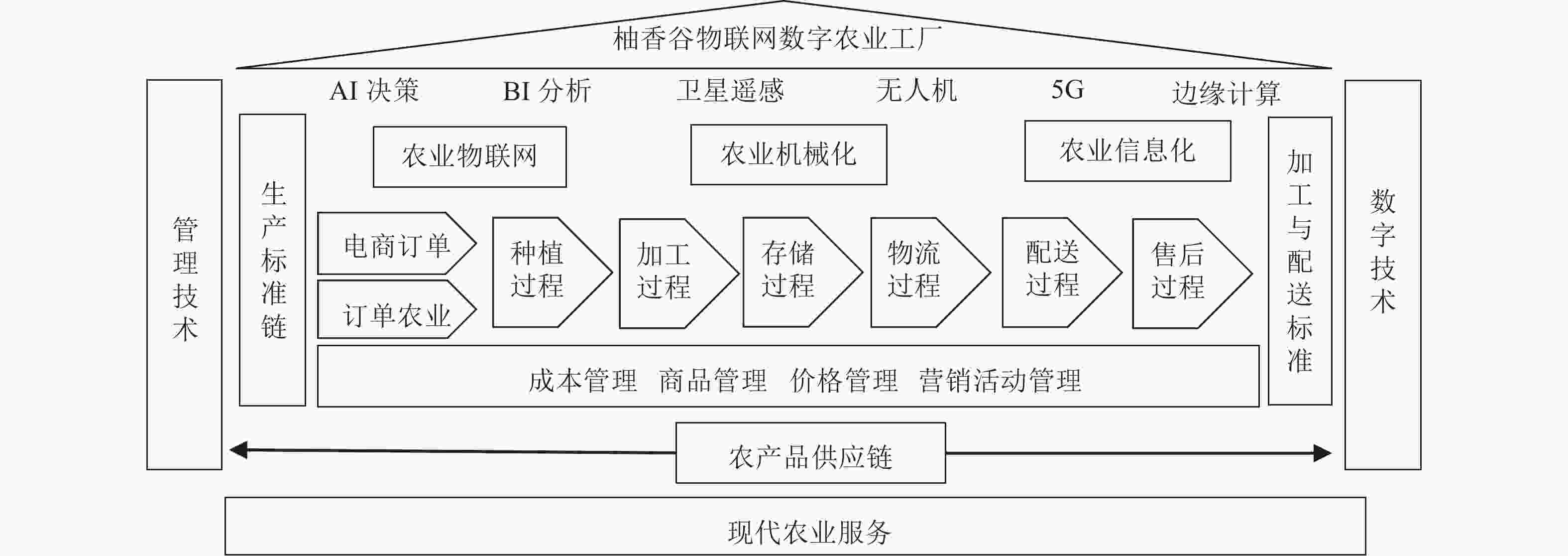

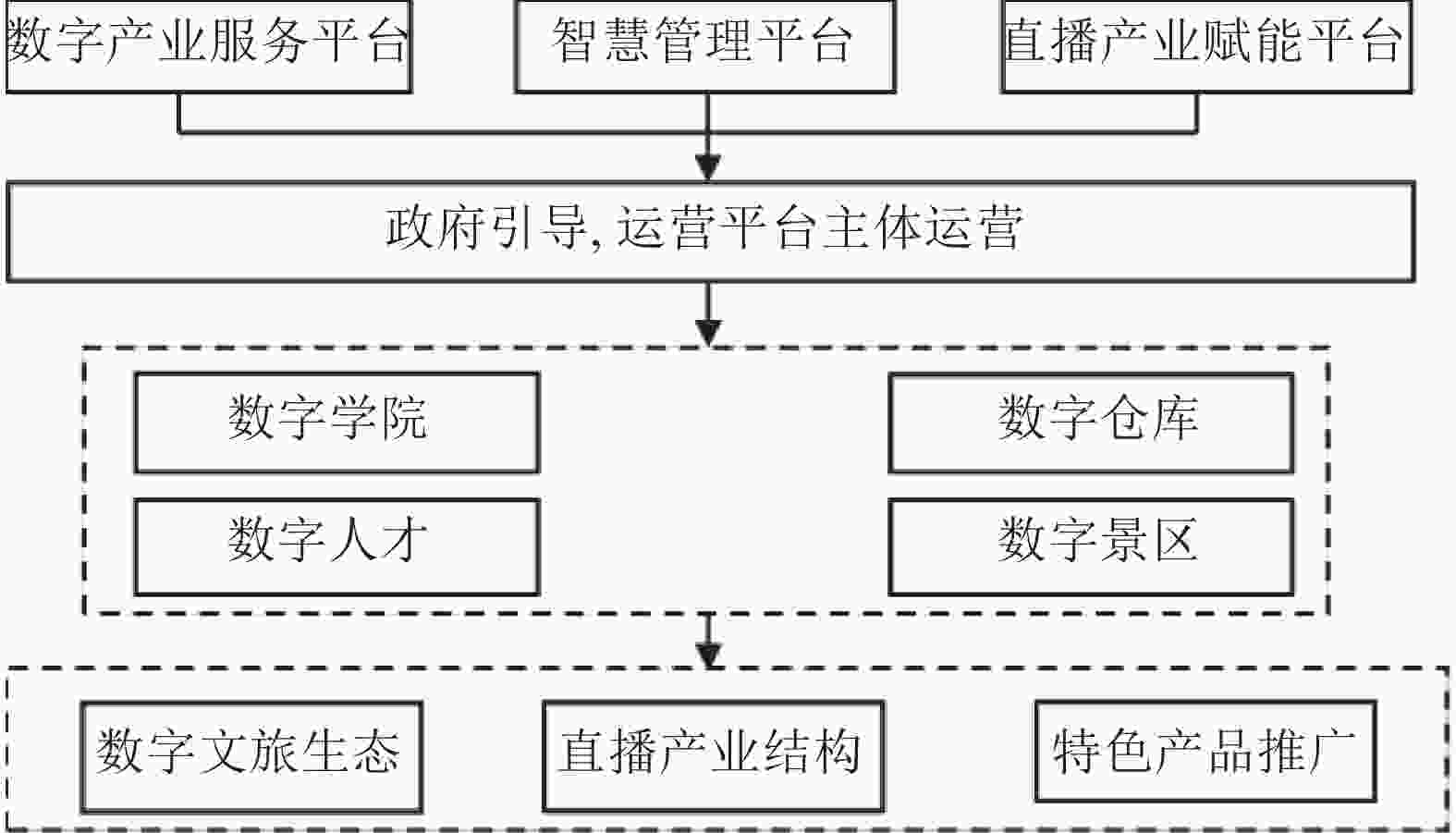
 DownLoad:
DownLoad:
